This simple Udon Noodle Soup with Toasted Mochi hits the spot any time of the day! The chewy mochi is unbeatable, but you can easily customize the rest of the toppings. To make it a vegan version, simply use kombu and shiitake dashi for your soup broth.
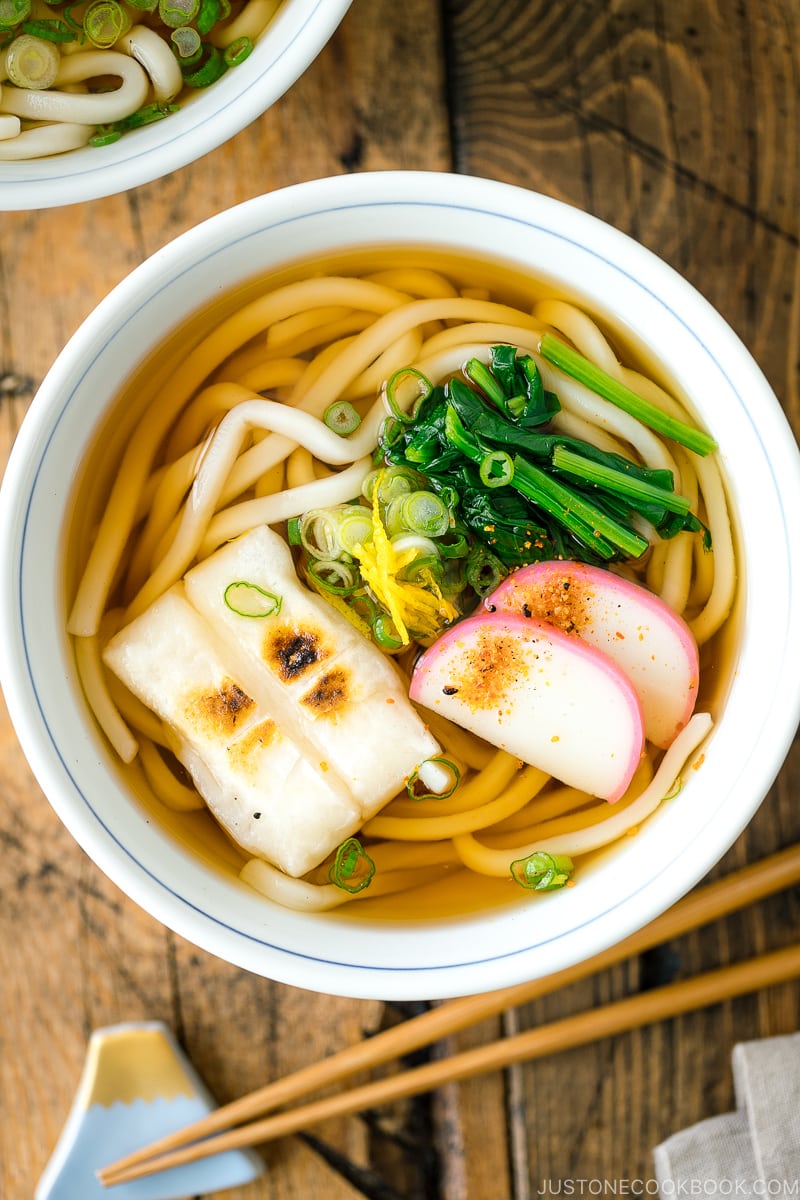
Growing up in Japan, I would devour anything that comes with mochi. When I say mochi, it usually means the plain rice cake and not the dessert “mochi” known outside of Japan (we call the sweet version “daifuku” or “daifuku mochi”).
One of the dishes that I always got excited about was Chikara Udon (力うどん), which is simply Udon Noodle Soup with Mochi on top. I know, it’s really simple, but to me, the addition of mochi is equivalent to the fluffy whipped cream on top of your favorite pie or cake.
Table of Contents
What is Chikara Udon?
As I explained earlier, chikara udon is a hot udon noodle soup topped with mochi (餅). Chikara (力) means power or strength in Japanese. In the old days, rice cake was a celebratory food and was considered the source of power and strength.
Also, the Japanese word for being powerful is “chikara mochi (力持ち)” with different kanji characters for “mochi (持ち)” but it’s a fun wordplay for chikara (Mochi) udon.
Do you need extra power to boost your energy? Let’s make Chikara Udon!
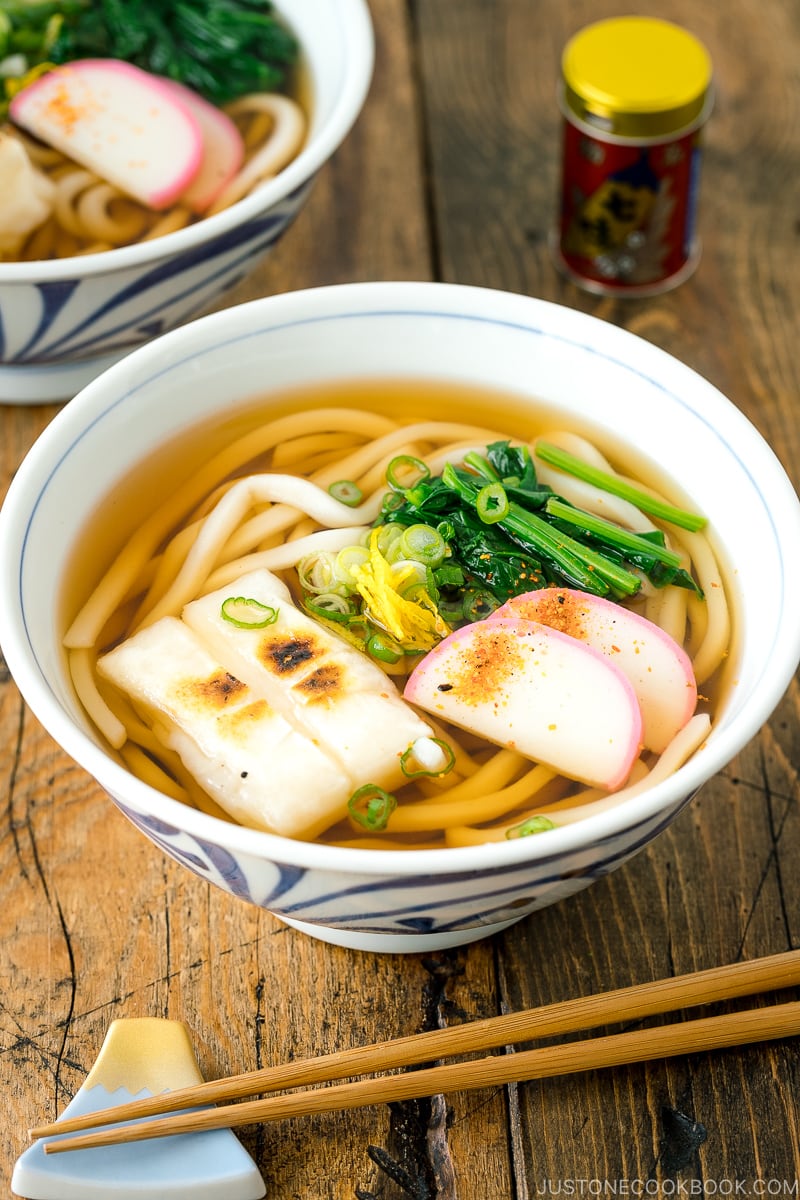
Ingredients for Chikara Udon
- Udon noodles — See different types below
- Soup broth — Dashi stock (vegan or regular), soy sauce, mirin, sugar, and salt
- Toppings — Kiri mochi (rice cake), wakame seaweed, spinach
How to Make Chikara Udon
- Make the udon broth.
- Blanch spinach.
- Cook udon noodles according to the package instructions.
- Toast the kiri mochi while cooking noodles.
- Assemble udon noodles, soup, and toppings. Enjoy!
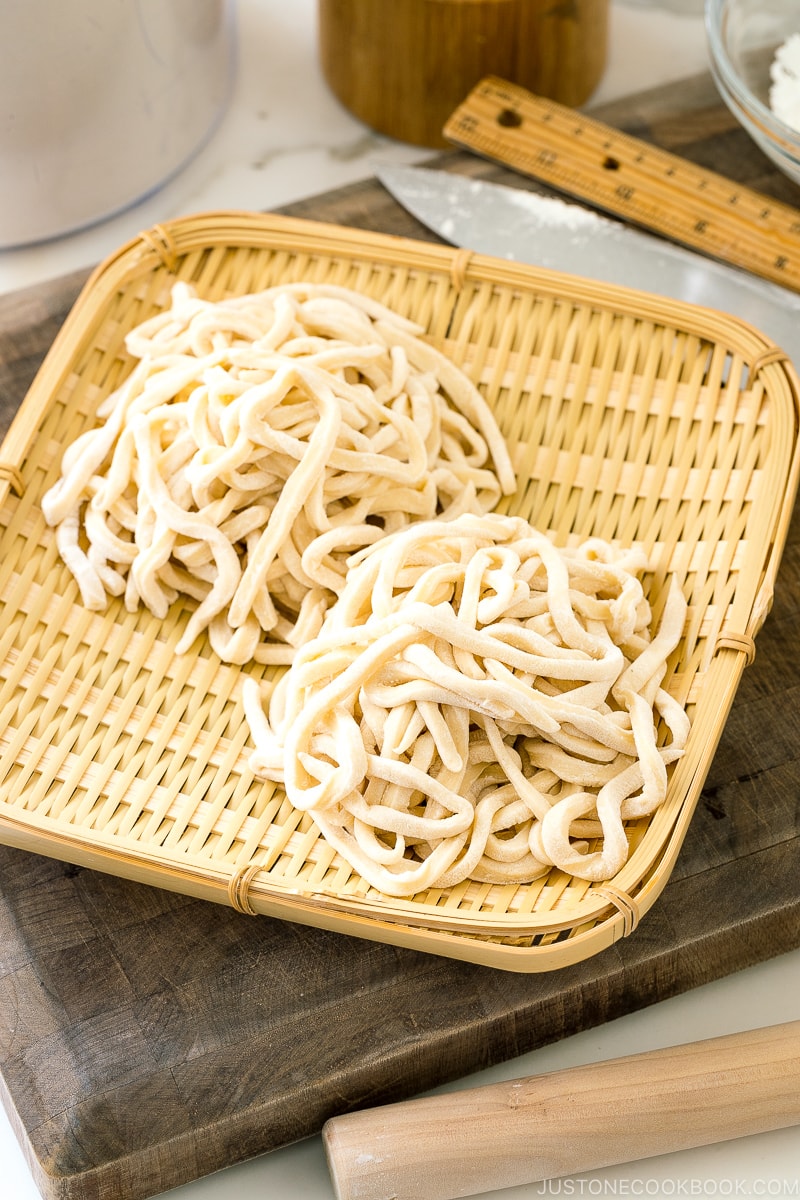
Different Types of Udon Noodles
If you’re ambitious, you can always make fresh udon noodles from scratch. It’s easy to make but it does take time as we have to rest the dough between the kneading process. Fresh udon noodles are amazing, and you definitely want to give them a try when you can!
For a quick meal, use frozen or dried udon noodles that are available at Japanese/Asian grocery stores.
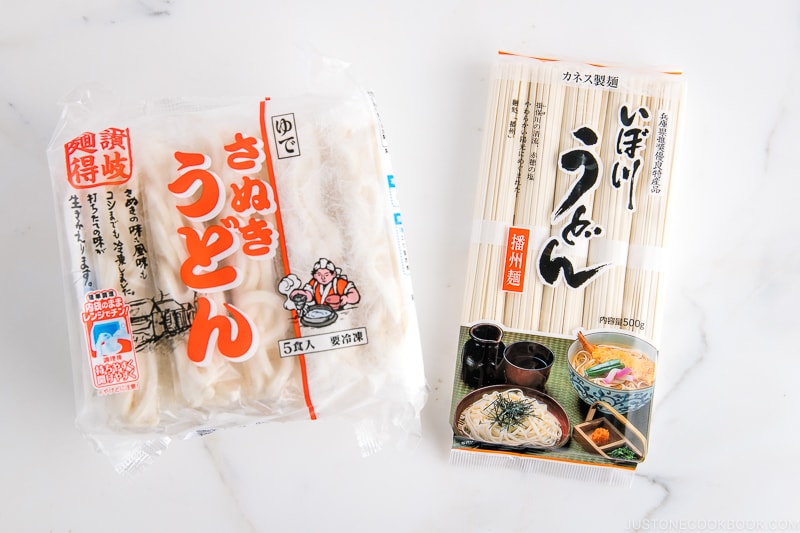
I personally like the frozen udon noodles as they are thick and chewy. They are cooked already, so you just need to cook for one minute in boiling water.
Dried udon noodles are very convenient as the packages are smaller and you can store them in your pantry for a long time. I do keep both types in my kitchen. Dried noodles have various thicknesses, so the cooking time varies.
You must cook udon noodles in separate boiling water and not directly in the soup because the starch will cloud your delicious soup.
How to Make Udon Soup Broth (Plus Vegan Option)
To make udon broth, you need to combine the following five ingredients:
- Dashi (Japanese soup stock)
- Soy sauce
- Mirin
- Sugar
- Salt
If you want to make a vegan broth for your udon noodles, you need to make Vegan Dashi with dried kelp and dried shiitake mushrooms.
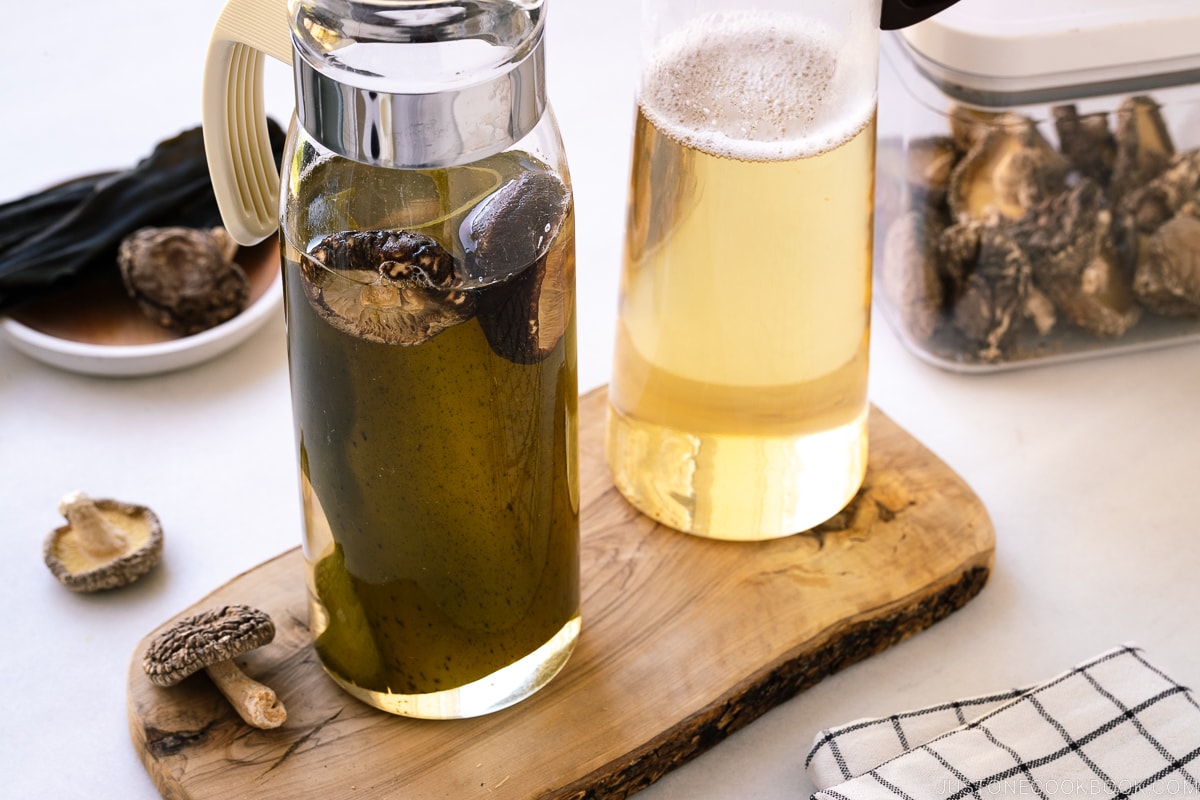
For the rest of us, I recommend making Awase Dashi—the combination of kombu and katsuobushi (dried bonito flakes). It’s really simple!
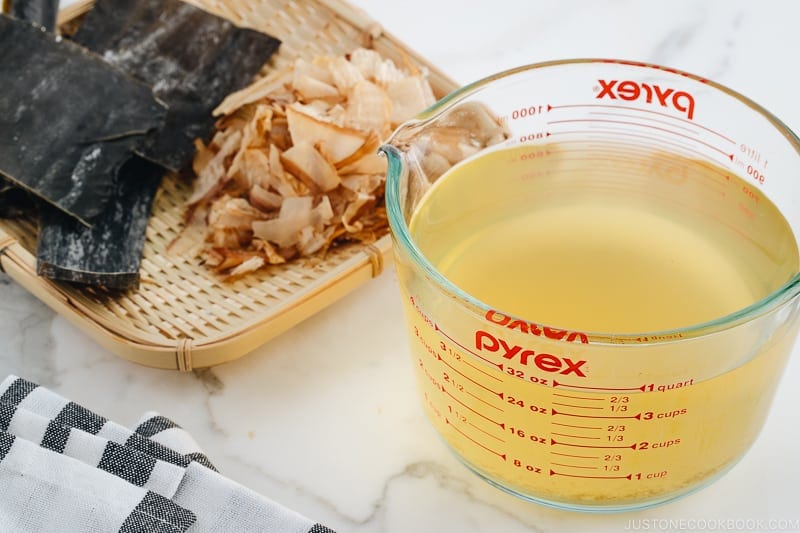
If you’re not sure, watch my 1-minute video to see how to prepare awase dashi. It only takes 20 minutes or less!
Are you not in the mood to buy obscure ingredients (kombu and katsuobushi)? You can always make dashi with a dashi packet or dashi powder. I prefer using a dashi packet over dashi powder for its superior flavor. Dashi is fundamental to Japanese cooking and you want a good stock to make Japanese food!
Shortcut for Making Udon Broth (Not Vegan)
If you’re like me who makes udon noodle soup for lunch regularly (like two to three times a week), another convenient option is to use bottled mentsuyu (tsuyu)—a soup base for noodles.
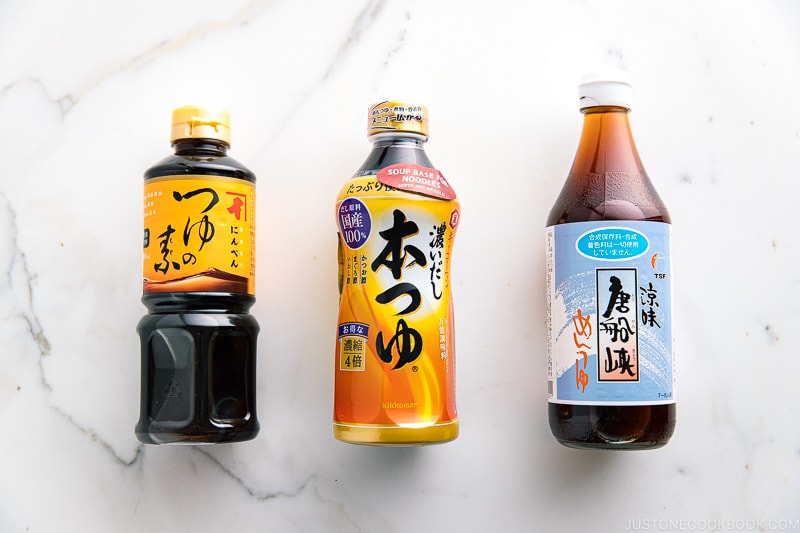
Each brand has specific instructions for the mentsuyu-to-water ratio to dilute before using it.
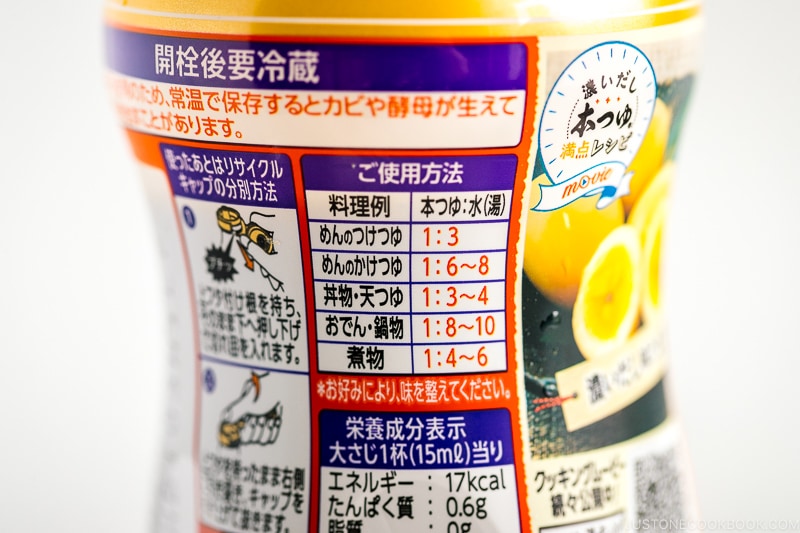
All you need to do is dilute the mentsuyu with water (I usually add a splash of mirin). If you go this route, you can skip making dashi!
And as always, you can make mentsuyu from scratch!
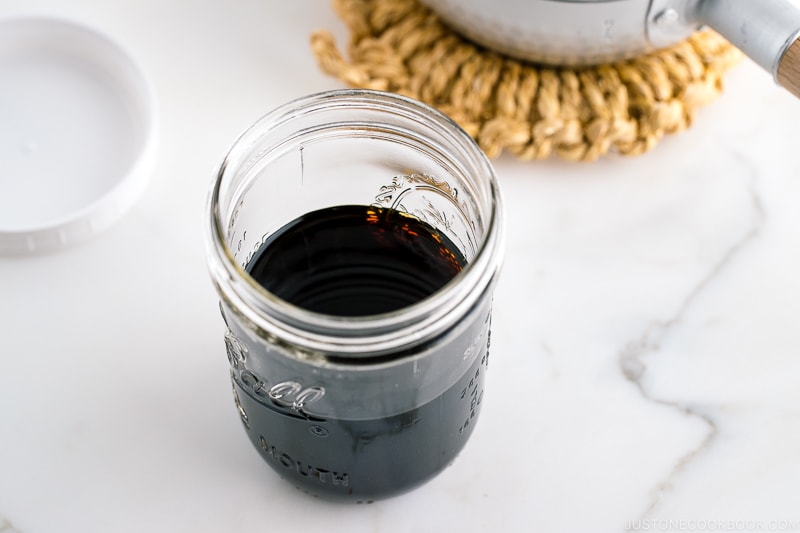
How to Cook Mochi
Let’s talk about the type of mochi you need to get for this recipe. You need kiri mochi (切り餅), which are the precut, dried mochi white rice cakes that come in individually wrapped packaging.
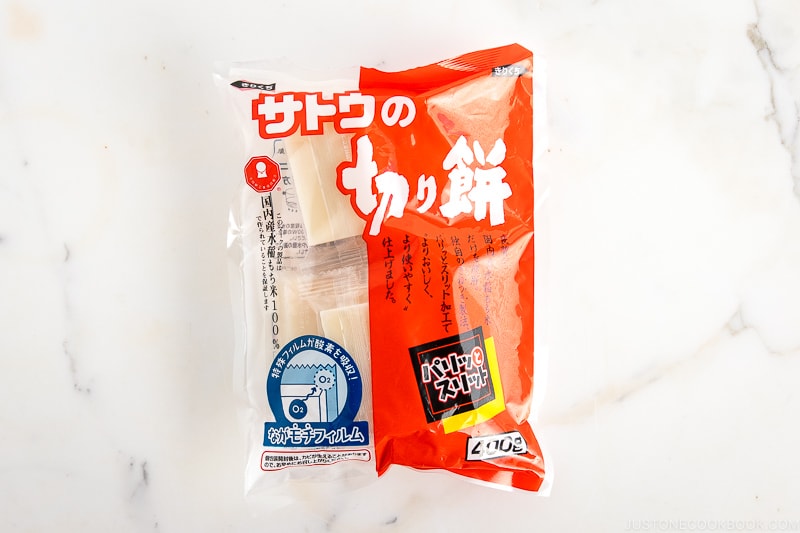
You will find it at Japanese grocery stores all year round. However, it’s possible you may have a hard time finding this at Asian grocery stores as it’s very specific to Japanese cooking.
Can’t find kiri mochi locally? Try Amazon.
To toast kiri mochi, use a toaster oven (it heats up faster), an oven, or a frying pan over the stove until mochi is golden and puffed up. I recommend toasting until at least one side of the kiri mochi is nicely browned.
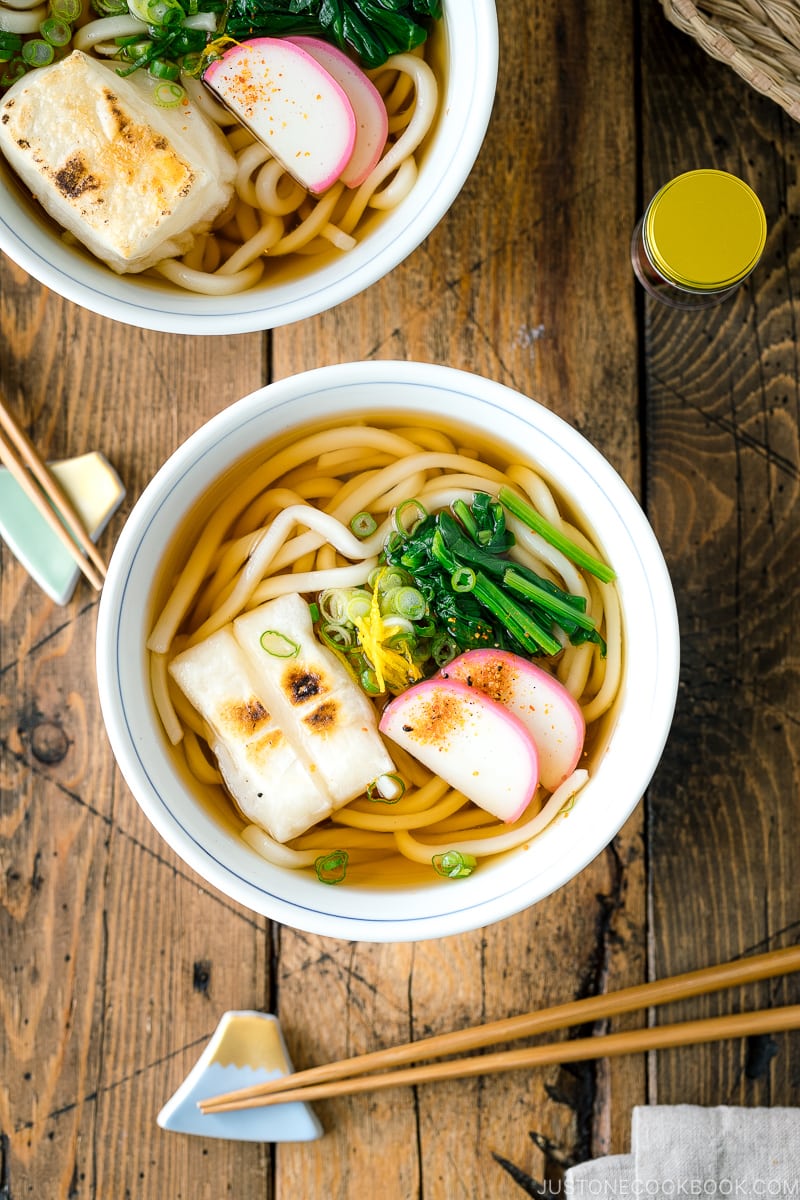
Topping Options Besides Mochi
Now that you have udon noodles, soup, and mochi, you can add the rest of the toppings.
When udon noodles are served in a bowl and poured with hot soup, it is called Kake Udon (Kake Soba if you’re serving soba noodles instead of udon). “Kake” (pronounced [kah keh]) means “pour something over” in Japanese. It’s a plain udon noodle soup with simple garnishes like scallions, wakame seaweed, and a few slices of fish cake (if fancy).
You’ll find a variation of udon noodle soups under different names when it stars a specific topping. Examples:
- Chikara Udon (this recipe) features toasted mochi
- Ebi Tempura Udon features shrimp tempura
- Kitsune Udon features seasoned inari age (tofu pouch)
- Niku Udon features stir-fried beef
You can add a small portion of other toppings. I usually think about the color of the dish when I decide on toppings. Here are some of the popular toppings and garnishes. (v) is for vegan options.
- Green onion/scallion (v)
- Spinach (v)
- Aburaage (fried tofu pouch) (v)
- Grated nagaimo (Japanese yam) (v)
- Tenkasu/Agedama (tempura scraps) (v)
- Tororo kombu (shaved kombu) (v)
- Nori seaweed (v)
- Wakame seaweed (v)
- Natto (v)
- Kamaboko (fish cake)
- Chikuwa (fish cake)
- Satsuma age (fish cake)
- Onsen tamago (poached egg)
- Fresh Kimchi
- Or any leftover protein or cooked vegetables
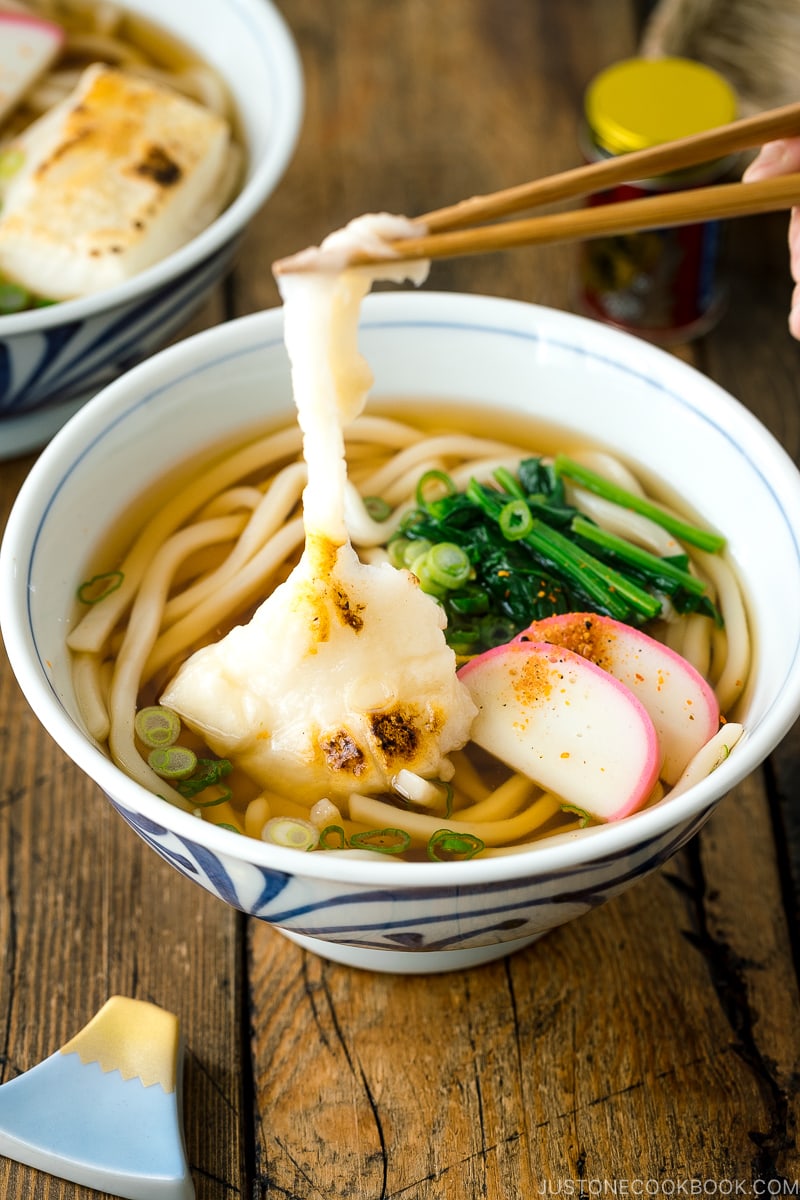
3 Important Cooking Tips
- Cook the noodles when everyone is seated or almost ready to eat. Soggy noodles in lukewarm udon broth is the worst experience. Make sure you can serve the dish when everyone’s ready to eat!
- Don’t overcook the udon noodles. Cook them right before you serve. All the toppings should be ready to go!
- Make the broth hot before serving. Most toppings are room temperature; so you’ll need super hot broth to warm them up immediately!
Frequent Asked Questions
Is this vegan?
Yes, it can be vegan if you use vegan dashi to make the broth. Please read the blog post as I explained in detail.
Can I make this ahead?
You can make the broth and prepare the toppings of your choice ahead of time. However, I highly recommend cooking udon noodles and toasting mochi right before you serve.
How do I keep the leftovers?
Udon noodles absorb soup easily and turn soggy if left uneaten once they start to cool. I recommend cooking only the exact amount of noodles you need and do not cook extra.
Other Delicious Udon Noodle Recipes
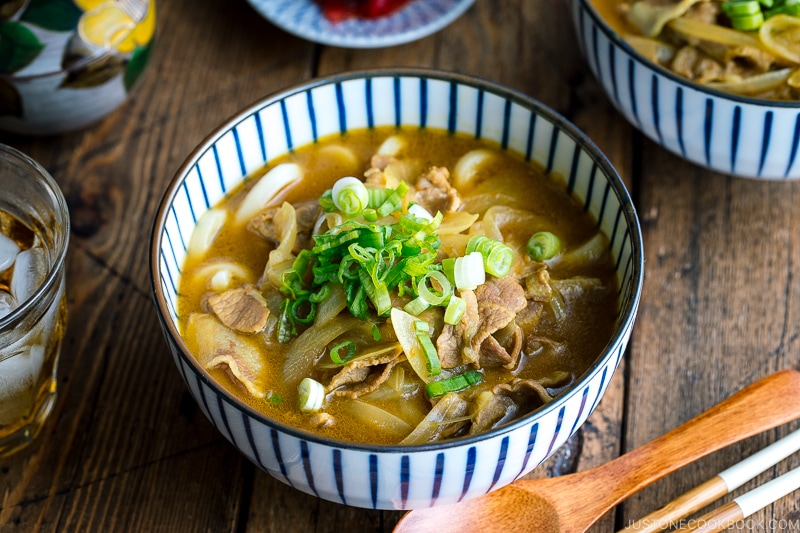
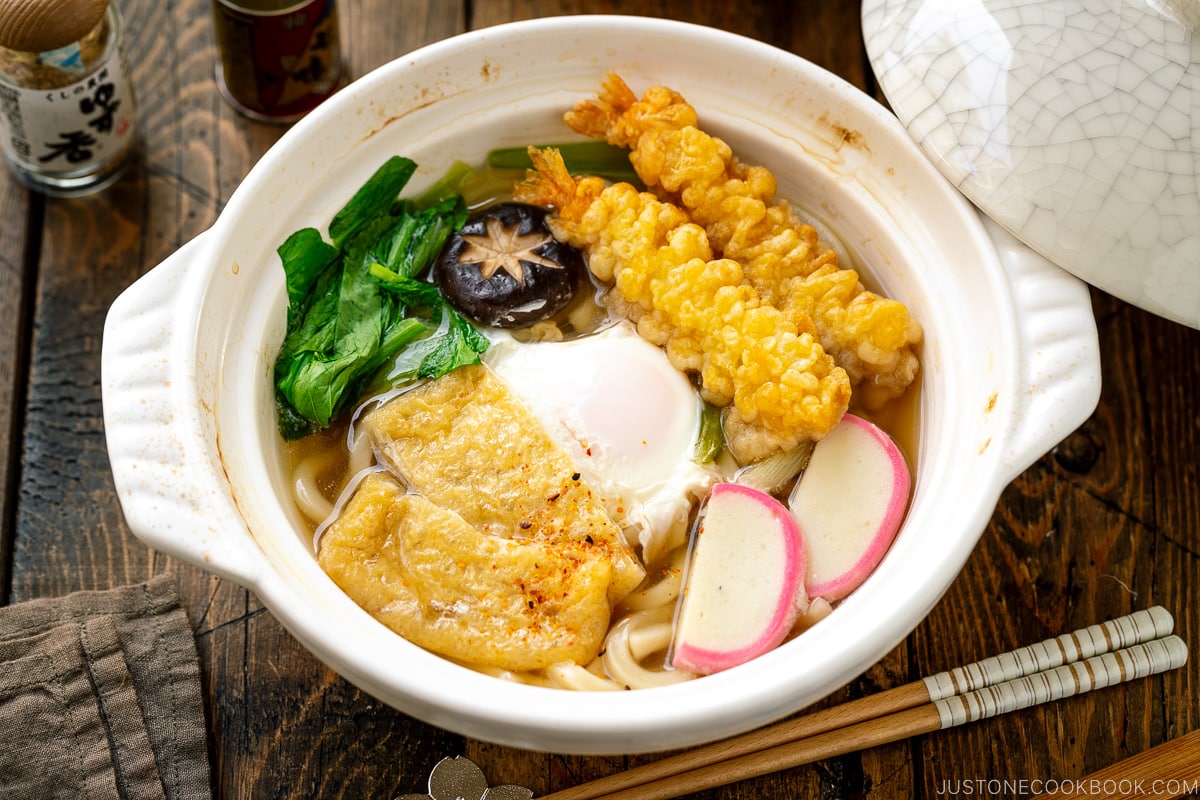
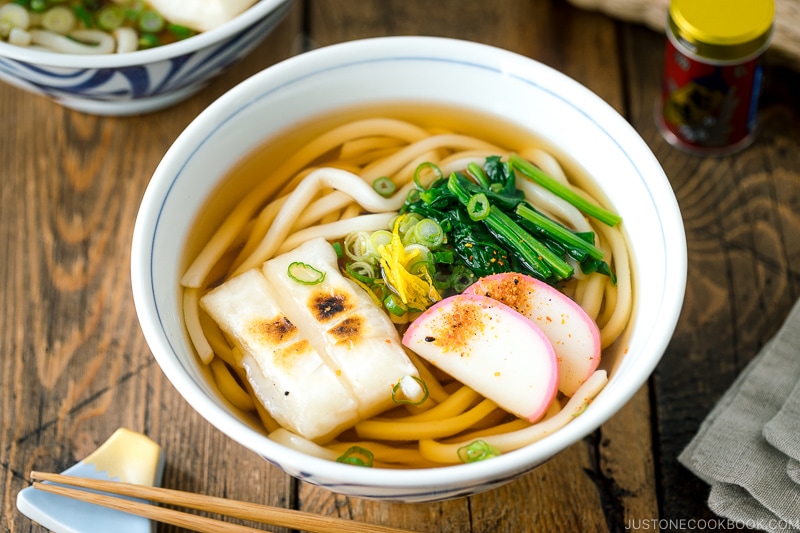
Wish to learn more about Japanese cooking? Sign up for our free newsletter to receive cooking tips & recipe updates! And stay in touch with me on Facebook, Pinterest, YouTube, and Instagram.
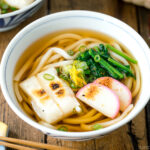
Udon Noodle Soup with Toasted Mochi (Chikara Udon)
Video
Ingredients
For the Udon Broth (with concentrated mentsuyu)
- 2⅓ cups water
- ⅓ cup mentsuyu (concentrated noodle soup base) (you can make my Homemade Mentsuyu)
- 1 Tbsp mirin
For the Udon Noodle Soup
- 2 pieces Japanese rice cake (kiri mochi)
- 4 slices kamaboko (fish cake) (optional; skip for vegan/vegetarian)
- 1 green onion/scallion
- 2 oz spinach (optional; you can use other vegetables)
- 2 servings udon noodles (1.1 lb/500 g frozen or parboiled udon noodles; 6.3 oz/180 g dry udon noodles)
- yuzu zest (optional; for the color and aroma)
- shichimi togarashi (Japanese seven spice) (for a spicy kick)
For the Udon Broth from Scratch (without mentsuyu; optional)
- 2½ cups dashi (Japanese soup stock) (I‘ll show you how to make a quick dashi using 2½ cups water and 1 dashi packet in this recipe; you can purchase it on Amazon; for vegan/vegetarian, make Vegan Dashi)
- 1½ Tbsp soy sauce
- 1 Tbsp mirin
- 1 tsp sugar
- ⅛ tsp Diamond Crystal kosher salt
Instructions
- Gather all the ingredients. Start bringing a big pot of water to a boil over medium-high heat.
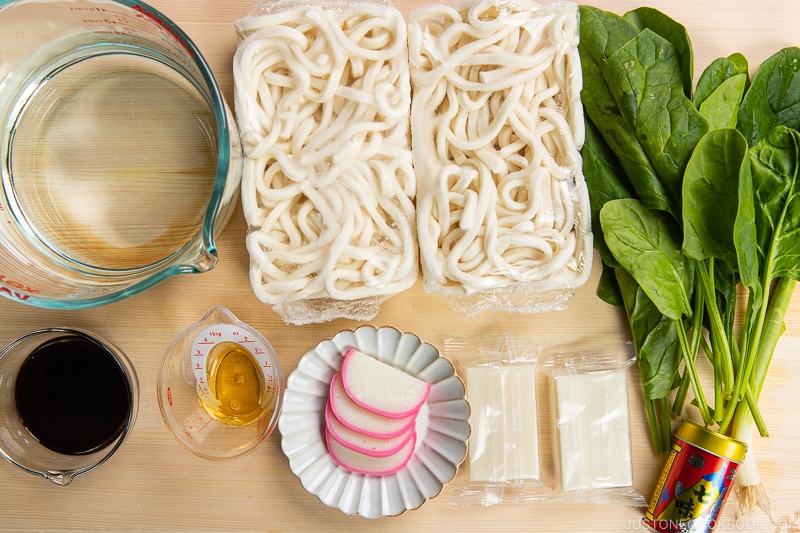
To Prepare the Udon Broth (with concentrated mentsuyu)
- In a medium saucepan, combine 2⅓ cups water, ⅓ cup mentsuyu (concentrated noodle soup base), and 1 Tbsp mirin and mix well. Bring the mixture to a gentle simmer over medium heat. Cover with a lid and turn off the heat. If you do not have mentsuyu, see the instructions below for how to cook udon broth from scratch.
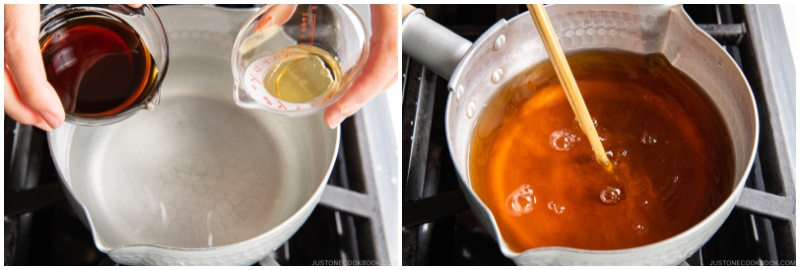
To Prepare the Toppings
- Using a toaster oven, standard oven, frying pan, or stovetop Japanese fish grill (I purchased this from a Japanese market), toast both sides of 2 pieces Japanese rice cake (kiri mochi) until they are browned and puffed up. Set them aside.
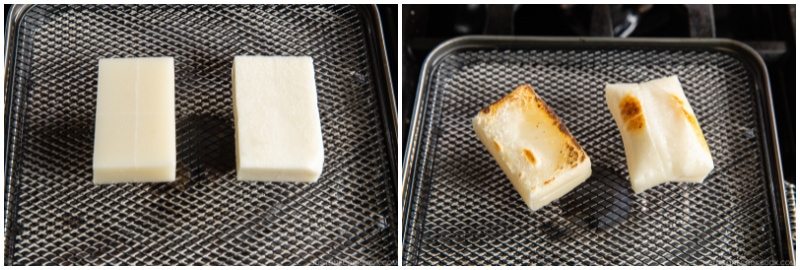
- Meanwhile, prepare the toppings. Cut 4 slices kamaboko (fish cake).
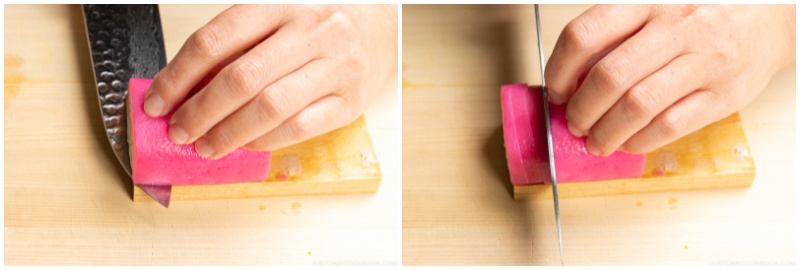
- Cut 1 green onion/scallion into thin rounds. Set aside. I also defrosted some yuzu zest (optional; here‘s how I freeze yuzu peels).
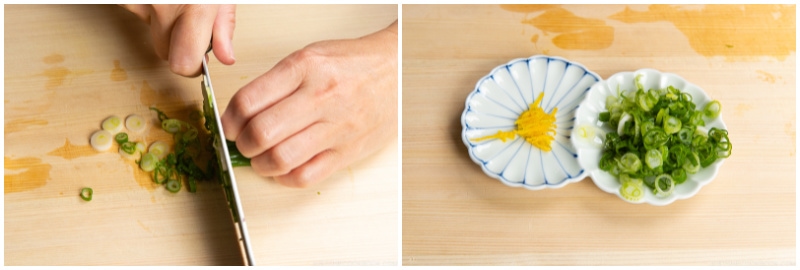
- When the water is boiling, blanch 2 oz spinach with the stem side down into the water first, for 30–45 seconds.
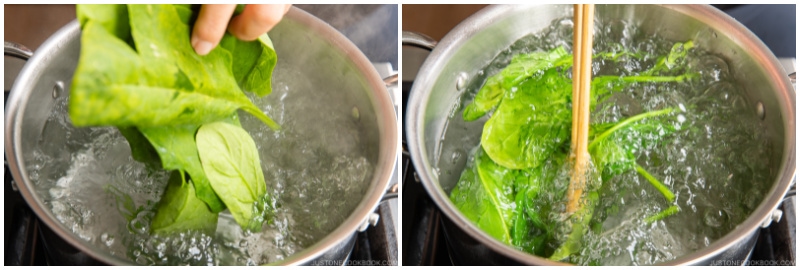
- Remove the spinach from the pot (and shock it in iced water to stop the cooking and bring out the bright color—but this step is optional). Squeeze the water out and cut the spinach into 2-inch (5-cm) pieces. Set aside.
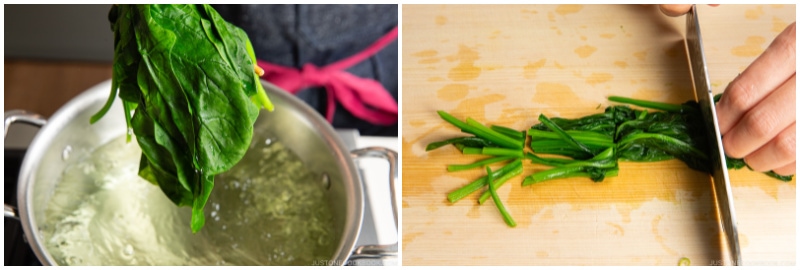
To Cook the Udon Noodles
- In the same pot of boiling water, cook 2 servings udon noodles according to the package instructions. For frozen udon noodles, cook for 1 minute. Drain the udon noodles completely.
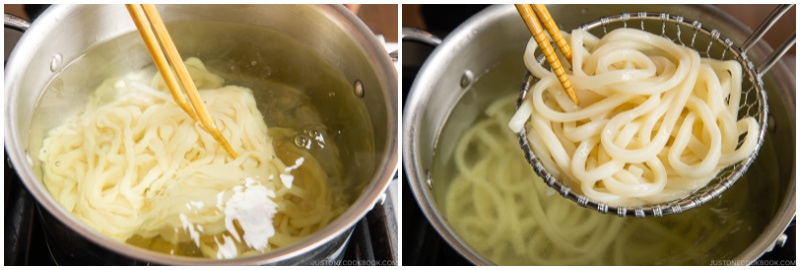
To Serve
- Transfer the udon noodles to individual bowls and pour udon broth to completely cover the noodles.
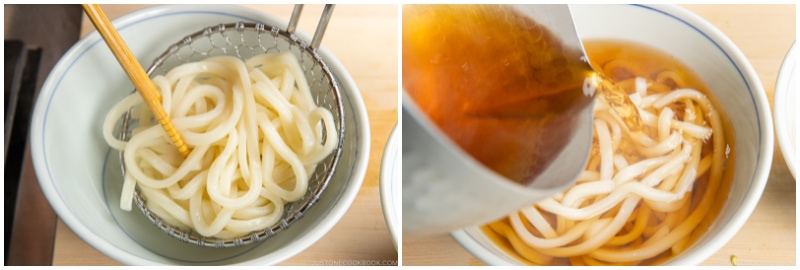
- Top the noodles with the toasted mochi, blanched spinach, chopped green onions, and yuzu zest (optional). Sprinkle with optional shichimi togarashi (Japanese seven spice) for a spicy kick.
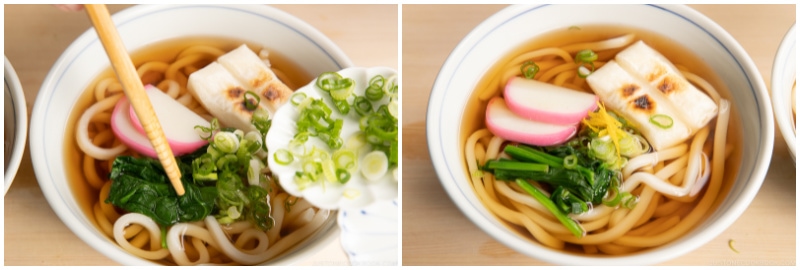
To Store
- You can keep the toppings and udon broth in separate airtight containers and store them in the refrigerator for 3 days. However, I highly recommend cooking the udon noodles and toasting the mochi right before you serve.
To Make the Udon Broth from Scratch (without Mentsuyu)
- In a medium saucepan, add 2½ cups water and 1 dashi packet. Bring it to a boil over medium heat. If you want to make dashi from scratch, follow my very easy tutorial How to Make Dashi. If you‘re vegan/vegetarian, make my Kombu Dashi or a combination of kombu dashi and Shiitake Dashi.
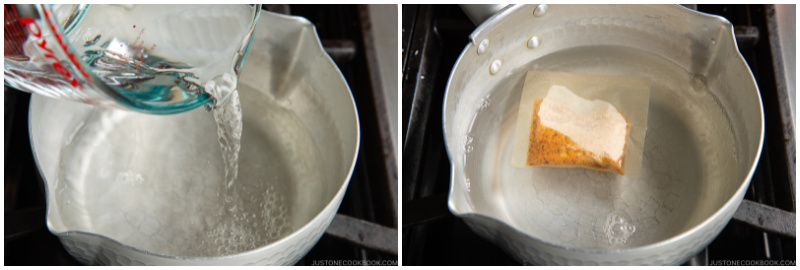
- Simmer for 2–3 minutes. Then squeeze the liquid from the dashi packet and discard the packet.
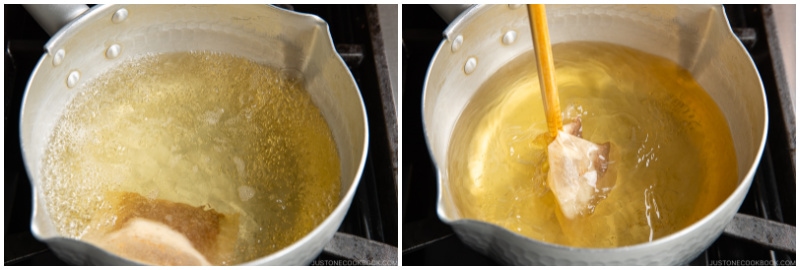
- Add 1½ Tbsp soy sauce, 1 Tbsp mirin, 1 tsp sugar, and ⅛ tsp Diamond Crystal kosher salt and mix it all together. Cover with a lid (don‘t let the soup evaporate) and remove it from the heat. Set aside. The udon broth is ready to use.
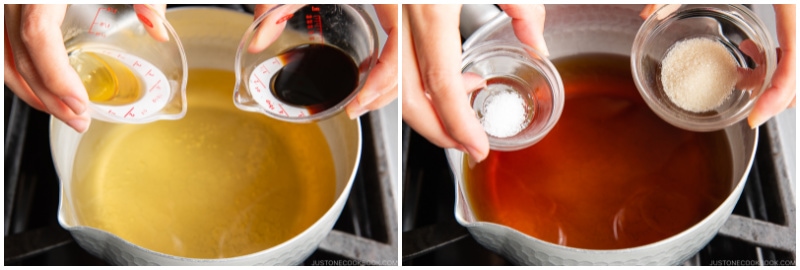
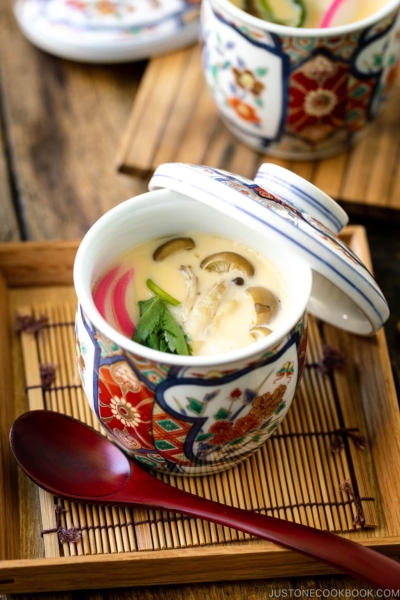
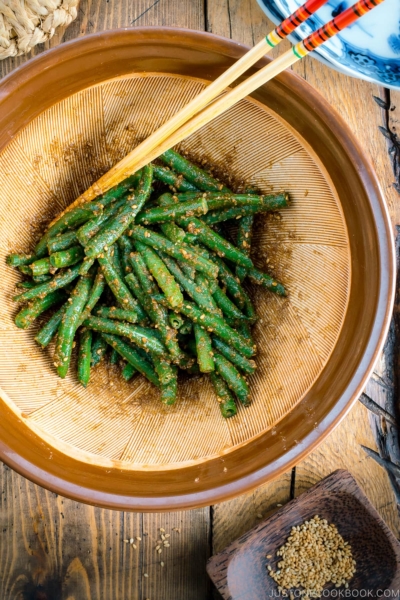

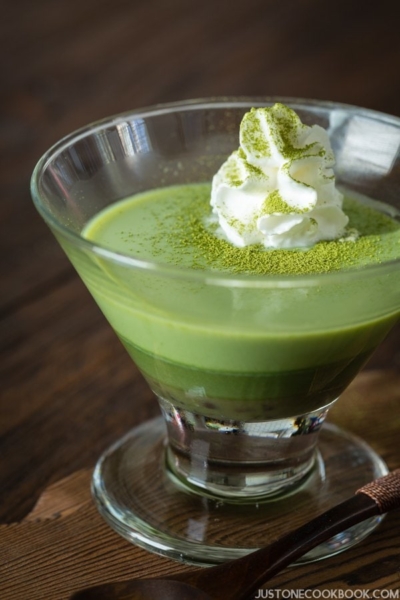




Wow, this recipe is wonderful! I used bok choi instead of spinach- I didn’t have an idea how long the mochi needed to cook in the toaster oven- I used the broil setting with the mochi on the ‘bake’ shelf- it was much faster than I thought and it browned and puffed so much more than I anticipated- it was beautiful!! About 4-5 minutes. The frozen udon is better than my homemade actually- I can’t get this round, bouncy shape even with my fancy Italian pasta maker!!
This is such a quick, fresh delicious soup- We ate it up and I didn’t think to take a pic until it was nearly gone….. sorry! I’ve made so many of your recipes, you are a godsend!!
Thank you!!!!
Hi, Kristi! We’re delighted you enjoyed the dish!
Thank you for trying Nami’s recipe and sharing your experiences with us. If you’re interested in making homemade Udon, we hope you’ll try Nami’s recipe! The results are quite impressive. 🤗
https://www.justonecookbook.com/udon-noodles/
Thank you for your lovely site. We were fortunate to visit Japan for a month last year. Your recipes remind us so much of the food we enjoyed, and now we are learning to cook them for ourselves.
Hello Chris! We’re delighted to hear you enjoyed the cuisine in Japan!
We hope you find many recipes on our website and try them. If you have any questions, please let us know. We’re here to help. Happy cooking!
Love your recipes!
I would love to make this at work but all we have is a toaster oven (for the mochi), a microwave, and a hot water pot.
Can I prepare the noodles using the boiled water in a bowl? Or should I prepare it at home and put it in a container for lunch?
Hello, Chiff! Thank you for trying Nami’s recipe.
If you use frozen udon noodles, you can cook them in the microwave instead. You can rinse them with running water, set the wet frozen noodles in a serving bowl, and microwave for 3 minutes (500w). Some frozen noodles are specially designed for microwave cooking as well. If you use dried noodles, it will be difficult to cook them in boiled water in a bowl or microwave, so cook them at home and reheat them in the microwave. We hope you enjoy a delicious lunch at work soon!
I bought some kiri mochi and put it in my toaster oven, but it puffed up an insane amount (literally tripled in size) without even browning… I had to take them out. Not sure what went wrong!
Hi Carly! Thank you so much for trying Nami’s recipe!
Depending on the toaster oven, the mochi will expand faster.
When mochi is baked, the moisture in it turns into steam, causing the mochi to bubble. Try toasting the mochi in the frying pan, as Nami did in the video. It might work better in your case.
We hope this helps!
I made the vegan version of this today with somen noodles – cause of course I realized I finished the udon the other…it was so so good!!! I can’t wait to try it with udon, and more toppings!!
First time having mochi with soup, and it was perfect!
Thank you for this great and super easy recipe!
Hi Cecile! We are so happy to hear you enjoy the mochi in the soup!
Thank you very much for trying Nami’s recipe and for your kind feedback!😊